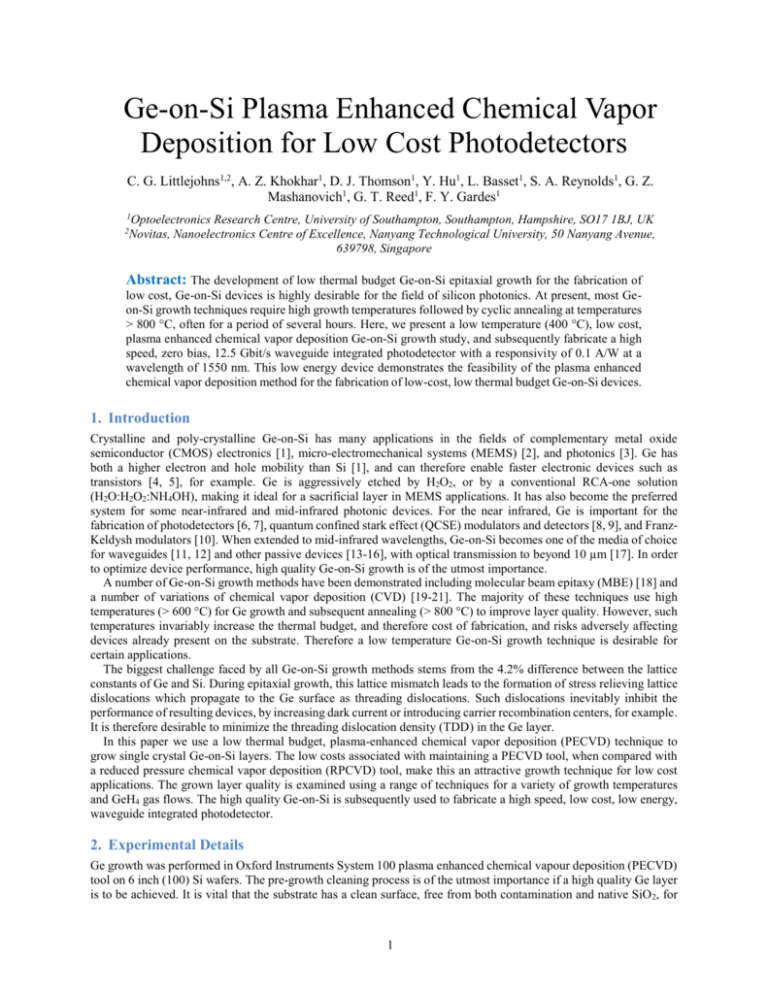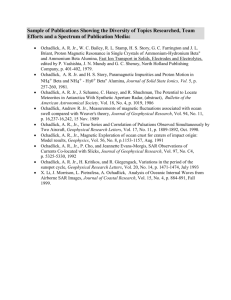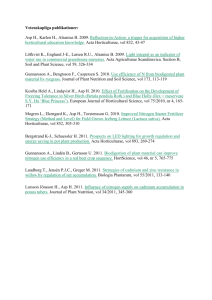- ePrints Soton
advertisement

Ge-on-Si Plasma Enhanced Chemical Vapor Deposition for Low Cost Photodetectors C. G. Littlejohns1,2, A. Z. Khokhar1, D. J. Thomson1, Y. Hu1, L. Basset1, S. A. Reynolds1, G. Z. Mashanovich1, G. T. Reed1, F. Y. Gardes1 1 Optoelectronics Research Centre, University of Southampton, Southampton, Hampshire, SO17 1BJ, UK Novitas, Nanoelectronics Centre of Excellence, Nanyang Technological University, 50 Nanyang Avenue, 639798, Singapore 2 Abstract: The development of low thermal budget Ge-on-Si epitaxial growth for the fabrication of low cost, Ge-on-Si devices is highly desirable for the field of silicon photonics. At present, most Geon-Si growth techniques require high growth temperatures followed by cyclic annealing at temperatures > 800 °C, often for a period of several hours. Here, we present a low temperature (400 °C), low cost, plasma enhanced chemical vapor deposition Ge-on-Si growth study, and subsequently fabricate a high speed, zero bias, 12.5 Gbit/s waveguide integrated photodetector with a responsivity of 0.1 A/W at a wavelength of 1550 nm. This low energy device demonstrates the feasibility of the plasma enhanced chemical vapor deposition method for the fabrication of low-cost, low thermal budget Ge-on-Si devices. 1. Introduction Crystalline and poly-crystalline Ge-on-Si has many applications in the fields of complementary metal oxide semiconductor (CMOS) electronics [1], micro-electromechanical systems (MEMS) [2], and photonics [3]. Ge has both a higher electron and hole mobility than Si [1], and can therefore enable faster electronic devices such as transistors [4, 5], for example. Ge is aggressively etched by H2O2, or by a conventional RCA-one solution (H2O:H2O2:NH4OH), making it ideal for a sacrificial layer in MEMS applications. It has also become the preferred system for some near-infrared and mid-infrared photonic devices. For the near infrared, Ge is important for the fabrication of photodetectors [6, 7], quantum confined stark effect (QCSE) modulators and detectors [8, 9], and FranzKeldysh modulators [10]. When extended to mid-infrared wavelengths, Ge-on-Si becomes one of the media of choice for waveguides [11, 12] and other passive devices [13-16], with optical transmission to beyond 10 µm [17]. In order to optimize device performance, high quality Ge-on-Si growth is of the utmost importance. A number of Ge-on-Si growth methods have been demonstrated including molecular beam epitaxy (MBE) [18] and a number of variations of chemical vapor deposition (CVD) [19-21]. The majority of these techniques use high temperatures (> 600 °C) for Ge growth and subsequent annealing (> 800 °C) to improve layer quality. However, such temperatures invariably increase the thermal budget, and therefore cost of fabrication, and risks adversely affecting devices already present on the substrate. Therefore a low temperature Ge-on-Si growth technique is desirable for certain applications. The biggest challenge faced by all Ge-on-Si growth methods stems from the 4.2% difference between the lattice constants of Ge and Si. During epitaxial growth, this lattice mismatch leads to the formation of stress relieving lattice dislocations which propagate to the Ge surface as threading dislocations. Such dislocations inevitably inhibit the performance of resulting devices, by increasing dark current or introducing carrier recombination centers, for example. It is therefore desirable to minimize the threading dislocation density (TDD) in the Ge layer. In this paper we use a low thermal budget, plasma-enhanced chemical vapor deposition (PECVD) technique to grow single crystal Ge-on-Si layers. The low costs associated with maintaining a PECVD tool, when compared with a reduced pressure chemical vapor deposition (RPCVD) tool, make this an attractive growth technique for low cost applications. The grown layer quality is examined using a range of techniques for a variety of growth temperatures and GeH4 gas flows. The high quality Ge-on-Si is subsequently used to fabricate a high speed, low cost, low energy, waveguide integrated photodetector. 2. Experimental Details Ge growth was performed in Oxford Instruments System 100 plasma enhanced chemical vapour deposition (PECVD) tool on 6 inch (100) Si wafers. The pre-growth cleaning process is of the utmost importance if a high quality Ge layer is to be achieved. It is vital that the substrate has a clean surface, free from both contamination and native SiO 2, for 1 the epitaxial layer to seed correctly. There are two main methods of pre-growth cleaning; an HF dip, or a high temperature bake at approximately 850 °C [22]. The HF dip removes the native SiO2 from the substrate surface, and forms a passivation layer with H terminated surface bonds, so that the wafer can be wet cleaned and handled in air. This enables the wafer to be transferred to the reaction chamber without the formation of a new native SiO2, by reducing the substrates reactivity with air by 13 orders of magnitude [22]. Alternatively, a high temperature bake (typically > 850 °C) desorbs the native SiO2 from the substrate surface. However, such a high temperature bake exceeds the low temperature restriction. Therefore, prior to growth, the Si wafers were cleaned in 20:1 dilute HF acid, before immediate loading into the PECVD chamber. An Ar diluted GeH4 (10%) precursor gas was used for all experiments. The chamber pressure was set to 500 mT for all experiments, with an H 2 gas flow of 100 standard cubic centimeters per minute (sccm), and a radio frequency (RF) power of 20 W. The temperature was varied between 250 °C and 400 °C, and the GeH4 gas flow was varied between 1.5 sccm and 10 sccm, as described in Table I. The role of H is very important in Ge-on-Si growth. Film crystal structure is primarily governed by the diffusion length of the precursors on the growing surface [23]. Crystallization is promoted by high H dilutions, such as those used for samples B-E, because H adsorption on the growing surface increases the diffusion length of the adsorbed Ge, resulting in the formation of crystallites. H may also act as an etchant that preferentially eliminates the energetically weakest Ge-Ge configurations associated with the amorphous phase, therefore leaving only the energetically stronger crystalline phases, similar to that observed with Si growth [24]. Additionally, H atoms may diffuse several layers into the growing film, which subsequently relaxes the Ge-Ge network, thereby enhancing the possibility of crystallite formation, again, similar to what is observed with Si growth [25]. Table I. Summary of process variables and characterisation results for the Ge-on-Si PECVD growth study. For all samples the growth pressure was 500 mT, the RF power was 20 W, and the H2 flow was 100 sccm. Poly = poly-crystalline, SC = single crystal. Sample GeH4 flow (sccm) Growth temp. (°C) Thickness (nm) Growth rate (nm/min) A 10 250 1250 4.17 B 2.5 250 980 1.09 C 2.5 400 922 1.01 D 1.5 400 625 0.52 E step 1 E step 2 2.5 1.5 250 400 ~15 690 ~1.09 0.52 Post growth anneal % with voids Crystal state Ge (400) FWHM (arcsec) / 600°C 2 mins / 600°C 2 mins / 600°C 2 mins / 600°C 2 mins / 600°C 2 mins 75 60 0 0 0 0 0 0 0 0 poly poly SC SC poly poly poly poly SC SC 2620 2150 2545 1115 2538 1109 2513 1089 2480 1012 RMS surface roughness (nm) 14.0 13.7 10.5 5.6 36.6 32.2 26.9 22.3 4.1 3.5 When 20 W of RF power is applied across the two electrodes in the CVD chamber, the GeH4 gas is broken down into Ge and H radicals. This has the benefit that the liberated H scavenges any oxygen in the chamber, therefore reducing oxide inclusions in the Ge film [26]. The 20 W of RF power was selected as a compromise between high growth rate and low void fraction [27]. After growth was complete and the wafers had been removed from the PECVD chamber, they were cleaved to enable a sample from each wafer to be annealed. This was carried out using a rapid thermal annealer (RTA) at 600 °C, in an inert N2 atmosphere, for 2 minutes, in order to reduce the TDD of the layer, decrease the surface roughness, and improve layer quality. The layers, both as grown and annealed, were then characterized using scanning electron microscopy (SEM) imaging, x-ray diffraction (XRD) rocking curves, electron backscatter diffraction (EBSD) maps, atomic force microscopy (AFM) surface roughness measurements, and in the case of Sample E, transmission electron microscopy (TEM) to estimate TDD. A summary of these results is detailed in Table I. 3. Results As observed by Poulsen et al. [27], a high growth rate resulted in voids observable in 75% of the Ge layer (sample A – see Fig. 1a). It is hypothesized that the lower portion of the layer is void free due to the relatively low stress levels. After approximately 426 nm voids begin to form in order to relieve the stress within the layer. In order to remove these voids, it was necessary to decrease the growth rate below 4 nm/min. This was achieved by increasing the dilution of the GeH4 precursor gas by reducing its flow to 2.5 sccm (sample B – see Fig. 1b). Once a void free layer had been 2 realized, the temperature was increased to 400 °C (sample C) in an attempt to improve the layer quality by increasing the surface adatom mobility, similar to what is observed with Si epitaxial growth [28]. However, it was found that at this higher temperature a large number of stress relieving pyramidal hillocks were present on the layer surface. It is predicted that this higher temperature favors Stransky-Krastanov growth, resulting in the initial formation of 3D islands at the Ge-Si interface. The growth rate at this temperature was subsequently reduced by a further decrease in the GeH4 flow to 1.5 sccm (sample D), but this resulted in a greater number of hillocks on the sample surface (see Fig. 1c). In order to reduce the number of hillocks on the layer surface, a 2-step growth process (sample E), comprising a low temperature step (250 °C) followed by a high temperature step (400 °C) was used. This resulted in a dramatic reduction in the number of hillocks observed on the Ge surface, due to the presence of the initial low temperature wetting layer. Further analysis of sample E is presented in Fig. 2 and Fig. 3. The Ge-on-Si growth (recipe E) is also non-selective to SiO2 surfaces (see Fig. 1d), unlike other CVD growth methods [29], making it suitable for the initial growth for rapid melt growth (RMG) applications [30], and other applications that require growth on SiO2. It is proposed that the presence of Ar (used to dilute GeH4) limits the Ge adatom surface mobility [31], so that nucleation occurs on the SiO2 surface as well as the Si surface. Fig. 1. SEM images of various Ge-on-Si PECVD growth recipes. a) Cross-section of sample A, showing voids in layer due to high growth rate, b) cross-section of sample B showing removal of voids by reducing the growth rate, c) plan view of sample D showing a high number of stress relieving pyramidal hillocks, d) angled cross-section of recipe E, grown on a patterned SiO2-on-Si wafer, showing non-selective growth and removal of stress relieving hillocks using a 2-step growth method. In order to estimate the TDD of sample E, TEM imaging was performed, on both the as grown (Fig. 2a) and annealed (Fig. 2b) samples. Prior to focused ion beam (FIB) milling, the samples were coated with carbon for protection and then imaged at 200 kV in bright-field TEM mode. 3 Fig. 2. TEM images of sample E showing the effects of annealing. a) As grown, b) after annealing at 600 °C for 2 minutes in an inert N2 atmosphere. From these images, it can be estimated by counting the threading dislocations, that the TDD is approximately 2x109 cm-2 prior to annealing, and approximately 3.3x108 cm-2 after annealing. This is a reduction in TDD of approximately one order of magnitude. It is proposed that the mechanism for defect reduction is thermal-stress induced dislocation glide and annihilation [32]. The anneal was performed at only 600 °C in order to maintain the low temperature process, in conjunction with a typical anneal temperature for dopant activation in Ge [33]. Therefore, a further improvement in TDD is expected with cyclic annealing at a higher temperature [34]. XRD rocking curve measurements were used as a measure of crystal quality [35]. The full width at half maximum (FWHM) of each peak is a measure of the mosaicity of the layer (i.e. the degree of mis-orientation from the perfect single crystal). As shown in Fig. 3a (sample E) and detailed in Table I, the mosaicity is improved by thermal annealing for all samples. Theta-2theta scans were used to determine the number of preferred crystal orientations in the Ge layer, to therefore conclude whether the layer was poly-crystalline or single crystal (see Table I). EBSD maps were also used to determine crystal orientation and grain size. The EBSD maps were converted into pole figures, as shown in Fig. 3b (sample E - annealed), which illustrate stereographic projections of the orientation distribution of crystallographic lattice planes, in this case when viewed from the (110) direction. This pole figure confirms that the material is single crystal. Finally, AFM maps were used to determine surface roughness, as shown in Fig. 3c (sample E - annealed), which indicates a root mean square (RMS) roughness of 3.5 nm for a Ge thickness of 690 nm. Other RMS roughness values are detailed in Table I. It is important that surface roughness is reduced in order to limit surface leakage currents, and optimize integration. Chemical mechanical polishing (CMP) can be used as a method of reducing surface roughness [29]. 4 Fig. 3. Ge characterisation showing the growth of a single crystal layer (sample E - annealed). a) XRD rocking curve showing the improvement in material quality after annealing, b) EBSD pole figure viewed from the (110) direction, c) AFM surface roughness scan showing an RMS roughness of 3.5 nm. The highest quality layer (sample E) was subsequently used to fabricate a low cost, waveguide integrated photodetector. Fabrication was carried out on 6 inch silicon-on-insulator (SOI) wafers, with a buried oxide (BOX) thickness of 2 µm, and a Si overlayer thickness of 400 nm. 350 nm deep trenches were etched into the Si overlayer using a 50 nm SiO2 hard mask, after which blanket, non-selective Ge growth was performed to a thickness of 350 nm. The Ge layer was subsequently etched via an inductively coupled plasma (ICP) process, with the SiO 2 layer acting as an etch stop. This leaves Ge only in the trenches, enabling a butt coupled device configuration. No thermal annealing of the Ge layer was performed, as a 600 °C dopant activation anneal was performed after ion implantation. 450 nm wide, single mode waveguides and associated grating couplers were then etched into the Si overlayer to enable coupling of light into the devices. Ion implantation was used to obtain a lateral p-i-n junction, which was then passivated with an SiO2 layer. Vias were etched into this SiO2 layer to enable Ti/Al metal contacts to be sputtered, which were defined by ICP etching. A schematic of the photodetector device and a cross-section FIB SEM image is shown in Fig. 4. The intrinsic region dimensions were L = 5 µm and W = 1.5 µm. Fig. 4. Waveguide integrated, butt coupled photodetector layout. a) Device schematic showing intrinsic region dimensions, b) cross section FIB SEM image of the fabricated device. The layer on top of the Al is a protective layer added prior to FIB milling for protection of the device. In order to measure the high-speed performance of the photodetectors, a modulated optical signal was generated using an electrical pseudo-random binary sequence (PRBS) source, driver amplifier and commercial LiNbO3 modulator. This signal was amplified using an erbium doped fiber amplifier (EDFA), and subsequently coupled to the device using an optical fiber and a grating coupler. The resulting open eye-diagrams for data rates in the range 1 Gbit/s to 12.5 Gbit/s at 0 V DC bias are shown in Fig. 5a-d. These diagrams show that the device is capable of working with no applied bias. This demonstrates the built-in electric field is sufficient to collect the generated carriers. Due to high 5 surface leakage current from some devices, the IV curves are rather variable, so detailed analysis may not be representative of all devices, so is the subject of future work. One of the better IV curves is shown in Fig. 5e. Fig. 5. Photodetector performance analysis showing eye diagrams at various data rates with zero volts applied bias, and IV characteristics. a) 1 Gbit/s, b) 5 Gbit/s, c) 10 Gbit/s, 12.5 Gbit/s, e) IV characteristics. Device intrinsic dimensions: W = 1.5 µm, L = 5 µm. λ = 1550 nm. The DC characteristics were measured by directly coupling light from a tunable wavelength laser into the photodetectors via an optical fiber and grating coupler. A responsivity of 0.1 A/W at 1550 nm was measured, with no applied bias. There are a number of potential reasons why the responsivity is fairly low. Firstly, it was observed during fabrication that there was a slight misalignment between the input waveguide and the central, intrinsic region of the photodetector. Therefore, some of the optical signal may be leaking into the doped regions, where any photogenerated carriers are likely to recombine before they are swept out of the device. Secondly, the high defect density of the Ge layer could lead to a small recombination time, even in the electric field, intrinsic region. Surface recombination is also prevalent in thin layers such as this. As a result, it is possible that not all of the photogenerated carriers are swept out of the device before they recombine, and therefore they do not contribute to the measured current. In addition, the surface leakage path effectively provides a parallel resistance to the current meter used to measure the photogenerated current. Therefore, the measured current may be lower than the actual photogenerated current due to some current flow through this leakage path. 4. Conclusion In conclusion, the low temperature PECVD Ge-on-Si growth method demonstrated here is suitable for low cost Ge devices such as photodetectors, for example, and can be performed using a commonly accessible tool. This is demonstrated by the fabrication of a 12.5 Gbit/s, zero bias, waveguide integrated photodetector. Acknowledgments The research leading to these results was funded by the UK Engineering and Physical Sciences Research Council (EPSRC) under the grants “UK Silicon Photonics”, “Silicon Photonics for Future Systems” and “HERMES”. The fabrication and characterisation was carried out at the Southampton Nano Centre, University of Southampton, UK. Germanium implants were performed at the Ion Beam Centre, University of Surrey, UK. The EBSD measurements were carried out by Thermo Fisher Scientific. References [1] [2] [3] R. Pillarisetty, "Academic and industry research progress in germanium nanodevices," Nature, vol. 479, pp. 324-328, 2011. M. Gad-el-Hak, The MEMS handbook, 2nd ed. vol. MEMS: Design and Fabrication Chapter 2.6. Boca Raton, London: CRC Taylor & Francis, 2006. J. Michel, J. Liu, and L. C. Kimerling, "High-performance Ge-on-Si photodetectors," Nat Photon, vol. 4, pp. 527-534, 2010. 6 [4] [5] [6] [7] [8] [9] [10] [11] [12] [13] [14] [15] [16] [17] [18] [19] [20] [21] [22] [23] [24] [25] [26] L. Zimmermann, D. J. Thomson, B. Goll, D. Knoll, S. Lischke, F. Y. Gardes, et al. (2013, Monolithically Integrated 10Gbit/sec Silicon Modulator with Driver in 0.25μm SiGe:C BiCMOS. IET Conference Proceedings, 504-506. D. J. Thomson, H. Porte, B. Goll, D. Knoll, S. Lischke, F. Y. Gardes, et al., "Silicon carrier depletion modulator with 10 Gbit/s driver realized in high-performance photonic BiCMOS," Laser & Photon. Rev., vol. 8, pp. 180187, 2014. C. G. Littlejohns, Y. Hu, F. Y. Gardes, D. J. Thomson, S. A. Reynolds, G. Z. Mashanovich, et al., "50 Gb/s silicon photonics receiver with low insertion loss," IEEE Photon. Technol. Lett., vol. 26, pp. 714-717, 2014. L. Virot, P. Crozat, J.-M. Fédéli, J.-M. Hartmann, D. Marris-Morini, E. Cassan, et al., "Germanium avalanche receiver for low power interconnects," Nat Commun, vol. 5, 2014. L. Lever, Y. Hu, M. Myronov, X. Liu, N. Owens, F. Gardes, et al., "Modulation of the absorption coefficient at 1.3 µm in Ge/SiGe multiple quantum well heterostructures on silicon," Opt. Lett., vol. 36, pp. 4158-60, 2011. P. Chaisakul, D. Marris-Morini, J. Frigerio, D. Chrastina, M.-S. Rouifed, S. Cecchi, et al., "Integrated germanium optical interconnects on silicon substrates," Nat. Photon., vol. 8, pp. 482-488, 2014. N.-N. Feng, D. Feng, S. Liao, X. Wang, P. Dong, H. Liang, et al., "30GHz Ge electro-absorption modulator integrated with 3µm silicon-on-insulator waveguide," Optics Express, vol. 19, pp. 7062-7067, 2011. G. Roelkens, U. Dave, A. Gassenq, N. Hattasan, H. Chen, B. Kuyken, et al., "Silicon-Based Photonic Integration Beyond the Telecommunication Wavelength Range," Selected Topics in Quantum Electronics, IEEE Journal of, vol. 20, pp. 394-404, 2014. G. Z. Mashanovich, F. Y. Gardes, D. J. Thomson, Y. Hu, K. Li, M. Nedeljkovic, et al., "Silicon Photonic Waveguides and Devices for Near- and Mid-IR Applications," Selected Topics in Quantum Electronics, IEEE Journal of, vol. 21, 2015. M. Nedeljkovic, J. Soler Penades, C. Mitchell, A. Khokhar, S. Stankovic, T. Dominguez Bucio, et al., "Surface Grating Coupled Low Loss Ge-on-Si Rib Waveguides and Multimode Interferometers," Photonics Technology Letters, vol. 27, pp. 1040-1043, 2015. L. Shen, N. Healy, C. J. Mitchell, J. S. Penades, M. Nedeljkovic, G. Z. Mashanovich, et al., "Mid-infrared alloptical modulation in low-loss germanium-on-silicon waveguides," Optics Letters, vol. 40, pp. 268-271, 2015. J. Soler Penades, Y. Hu, M. Nedeljkovic, C. G. Littlejohns, A. Z. Khokhar, C. J. Mitchell, et al., "Angled MMI CWDM structure on Germanium on Silicon," presented at the CLEO Europe, Munich, Germany, 2015. M. Nedeljkovic, R. Soref, and G. Z. Mashanovich, "Predictions of free-carrier electroabsorption and electrorefraction in germanium," IEEE Photonics Journal, vol. 7, 2015. R. A. Soref, S. J. Emelett, and W. R. Buchwald, "Silicon waveguided components for the long-wave infrared region," Journal of Optics A: Pure and Applied Optics, vol. 8, p. 840, 2006. J. Liu, H. J. Kim, O. Hul'ko, Y. H. Xie, S. Sahni, P. Bandaru, et al., "Ge films grown on Si substrates by molecular-beam epitaxy below 450 °C," Journal of Applied Physics, vol. 96, pp. 916-918, 2004. H. C. Luan, K. Wada, L. C. Kimerling, G. Masini, L. Colace, and G. Assanto, "High efficiency photodetectors based on high quality epitaxial germanium grown on silicon substrates," Optical Materials, vol. 17, pp. 71-73, 2001. J. M. Hartmann, A. Abbadie, A. M. Papon, P. Holliger, G. Rolland, T. Billon, et al., "Reduced pressure chemical vapor deposition of Ge thick layers on Si(001) for 1.3 - 1.55 µm photodetection," Journal of Applied Physics, vol. 95, pp. 5905-5913, 2004. J. Osmond, G. Isella, D. Chrastina, R. Kaufmann, M. Acciarri, and H. von Kanel, "Ultralow dark current Ge/Si(100) photodiodes with low thermal budget," Applied Physics Letters, vol. 94, pp. 201106-3, 2009. D. L. Harame and B. S. Meyerson, "The early history of IBM's SiGe mixed signal technology," Electron Devices, IEEE Transactions on, vol. 48, pp. 2555-2567, 2001. A. Matsuda, "Formation kinetics and control of microcrystallite in μc-Si:H from glow discharge plasma," Journal of Non-Crystalline Solids, vol. 59–60, pp. 767-774, 1983. Y. S. Tsuo, Y. Xu, E. A. Ramsay, R. S. Crandall, S. J. Salomon, I. Balberg, et al., "Methods of Improving Glow-Discharge-Deposited a-Si1−xGex:H," MRS Online Proceedings Library, vol. 219, 1991. N. Shibata, K. Fukuda, H. Ohtoshi, J. Hanna, S. Oda, and I. Shimizu, "Growth of Amorphous and Crystalline Silicon by HR-CVD (Hydrogen Radical Enhanced CVD)," MRS Online Proceedings Library, vol. 95, 1987. V. A. Vu, D. E. Ioannou, R. Kamocsai, S. L. Hyland, A. Pomerene, and D. Carothers, "PIN Germanium Photodetector Fabrication Issues and Manufacturability," Semiconductor Manufacturing, IEEE Transactions on, vol. 23, pp. 411-418, 2010. 7 [27] [28] [29] [30] [31] [32] [33] [34] [35] P. R. Poulsen, M. Wang, J. Xu, W. Li, K. Chen, G. Wang, et al., "Role of hydrogen surface coverage during anodic plasma deposition of hydrogenated nanocrystalline germanium," Journal of Applied Physics, vol. 84, pp. 3386-3391, 1998. K. R. Bray, A. Gupta, and G. N. Parsons, "Effect of hydrogen on adsorbed precursor diffusion kinetics during hydrogenated amorphous silicon deposition," Applied Physics Letters, vol. 80, pp. 2356-2358, 2002. L. Vivien, A. Polzer, D. Marris-Morini, J. Osmond, J. M. Hartmann, P. Crozat, et al., "Zero-bias 40Gbit/s germanium waveguide photodetector on silicon," Opt. Express, vol. 20, pp. 1096-1101, 2012. C. Littlejohns, M. Nedeljkovic, C. Mallinson, J. Watts, G. Mashanovich, G. Reed, et al., "Next generation device grade silicon-germanium on insulator," Sci. Rep., vol. 5, p. 8288, 2015. R. R. Lieten, S. Degroote, F. Clemente, M. Leys, and G. Borghs, "Hydrogen and inert species in solid phase epitaxy," Applied Physics Letters, vol. 96, pp. 052109-3, 2010. G. E. Beltz, M. Chang, M. A. Eardley, W. Pompe, A. E. Romanov, and J. S. Speck, "A theoretical model for threading dislocation reduction during selective area growth," Materials Science and Engineering: A, vol. 234– 236, pp. 794-797, 1997. J. Vanhellemont and E. Simoen, "On the diffusion and activation of n-type dopants in Ge," Materials Science in Semiconductor Processing, vol. 15, pp. 642-655, 2012. L. Colace, G. Masini, G. Assanto, H.-C. Luan, K. Wada, and L. C. Kimerling, "Efficient high-speed nearinfrared Ge photodetectors integrated on Si substrates," Applied Physics Letters, vol. 76, pp. 1231-1233, 2000. T. Mitsunaga, "X-ray Thin-Film Measurement Techniques: Out-of-Plane Diffraction Measurements," The Rigaku Journal, vol. 25, 2009. 8




